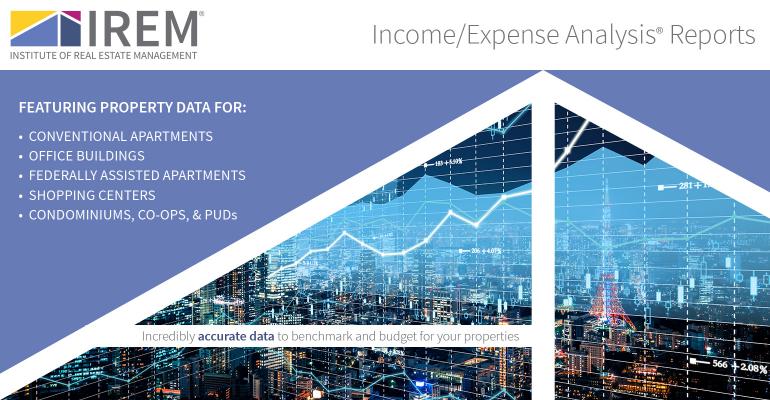Sponsored by IREM
As the demand for performance benchmarking rises, the availability of accurate data becomes increasingly important. Real estate managers across all property sectors rely on accurate benchmarking information to make sound decisions on everything from assessing their properties' operating efficiency to comparing their property performance against others in the competitive set.
With the most recent release of their annual Income/Expense Analysis Reports®, IREM (Institute of Real Estate Management) aims to alleviate the risk and uncertainty that real estate managers face. These reports are comprehensive, detailed studies featuring income and expense data from over 10,000 properties in major metropolitan properties and regions across the U.S. The reports cover five different property types (Condominiums, Cooperatives & Planned Unit Developments; Conventional Apartments; Federally Assisted Apartments; Office Buildings; and Shopping Centers) and allow real estate management professionals access to information on revenue, expense, and vacancy trends; turnover trends; energy consumption analysis; utility and maintenance costs; tax and payroll expenses; and much more.
"Everybody is stressed and feels they have to do more in less time. What's important about benchmarking is vettable data that's been scrubbed, relied upon, and contributed by property managers who want to contribute good data to make good decisions," notes Craig Cardwell, CPM®, Principal at Island Investment Interests. "That's the biggest mistake people make - they don't benchmark. It's a big mistake and it crosses all sectors of the industry."
Trend Highlights Include:
Office Buildings: Operating data from office properties in both downtown and surburban areas reflect a mature real estate market and a strong job market. This can be seen in building occupancy levels, which remained steady or increased in 2017.
- Total actual collections trended downward from $19.76 per sq. ft. in 2016 to $19.66 in 2017 for suburban office buildings and from $24.05 per sq. ft. in 2016 to $22.19 in 2017 for downtown office buildings.
Conventional apartments: Urged on by renters-by-choice - including both millennials and baby boomers seeking to downsize - as well as for affordability reasons, the fundamental demand for rental housing continued unabated in 2017. The steadiness of the market is reflected in operating results for conventional apartments reported.
- Gross possible rent grew more than 3% across all building types – somewhat more aligned with historical rent growth than in prior years.
- The data does show an increase in vacancy and rent loss. On a national level, elevator buildings took the dubious lead in this area, clocking in at 7.1% vacancy.
Shopping Centers: Gross minimum rents, actual minimum rents, and total annual income all fell between 2016 and 2017, as did occupancy rates. Looking at the shopping center market from a national level, based on gross leasable area (GLA):
- Gross minimum rents fell from $15.22 per sq. ft. in 2016 to $14.57 in 2017
- Total annual median income per square foot similarly fell – from $17.26 in 2016 to $16.01 in 2017
Federally Assisted Apartments: Some 5 million low-income household in the United States receive federal rental assistance, according to U.S. government estimates, enabling them to rent modest housing at an affordable cost.
- Expenses grew from $6.90 in 2016 to $7.85 in 2017, resulting in net operating income of $4.76 per sq. ft. in 2017, down from $4.91 in 2016.
Condominiums, Cooperatives, and Planned Unit Developments: Current estimates indicated that 20% of the U.S. population - one out of every five Americans - lives in a homeowners' association community of some type, including high-rise condos in urban centers to sprawling planned unit developments.
- For condominiums, total operating expenses across all building types dropped by .4% to $2,980.72 in 2017.
- A more detailed look reveals that high-rise buildings’ expenses increased by 5.4%, while townhouse properties’ expenses decreased by 8.1%.
To learn more about IREM’s Income/Expense Analysis Reports, click here.

